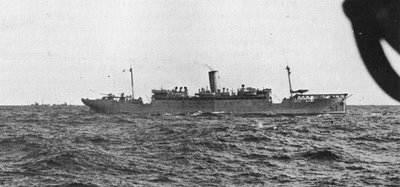

Tough times call for some innovative measures, and converting merchant hulls to use as aircraft carriers in WWII was one such extraordinary effort. As set out here :
Merchant aircraft carriers (MAC) were minimal aircraft carriers used during World War II by Britain and the Netherlands as an emergency measure ...
They were bulk grain carriers or tankers built with flight decks and small islands, but no catapult or other aircraft support facilities. The nature of the cargoes removed the need for the type of deck mounted cargo-handling gear needed by general freighters. They operated with civilian crews, under merchant colors, and carried their regular cargo while serving as aircraft carriers. Their fighter planes were primarily intended to attack long-range reconnaissance aircraft such as the Fw 200 Condor and the Junkers Ju 290 to prevent tracking of convoys.
The tanker conversions had no hangar, the grain ships did but it was small (four Fairey Swordfish was the limit). Flight decks were around 460 feet long on the tankers and between 413 and 424 for the grain ships, width was 62 feet in all cases. Aircrew accomodation was minimalistic and ammunition and fuel stores were neither armoured nor partitioned.
***
The 'Air Party' consisted of an Air Staff Officer (Lt-Commander), the aircrew, a doctor, a batsman (landing control officer), ten ship's gunners, four signalmen, and three or four Able Seamen. The Merchant Navy part of the crew might have an extra mate and/or wireless operator but was otherwise unchanged.
***
In practice, the MAC ships were successful. The antiquated, but robust, Swordfish aircraft were suited to the conditions and their patrols were very effective. Flying more than 4000 sorties in all, wartime records show that no convoy with an accompanying MAC ship ever lost a vessel to U-boats.


In addition to the merchant aircraft carriers, there were merchant ships equipped with catapults, "CAM" ships (Catapult Aircraft Merchantman":
...CAM ship was equipped with a rocket-propelled catapult launching a single Hawker Sea Hurricane, dubbed a "Hurricat" or "Catafighter". The ship was not fitted for landings so the pilot would bail out or ditch in the sea at the end of the flight and the plane would be lost. In 1940-41 35 ships were converted, starting with SS Michael E, and continued to carry their normal cargoes after conversion.Note that all of the ships converted still carried out duties as cargo carriers or tankers.
Photos: MAC "Empire MacCabe", a Swordfish aircraft, CAM ship (see the catapult on the bow?) and a Hawker Sea Hurricane.
UPDATE: About 20 years ago, the US Navy was testing a similar program called ARAPAHO:
In the Arapaho program, the Naval Air Systems Command developed a portable, modularized aviation facility intended for installation aboard container ships. It can be installed in less than twenty-four hours and included all components necessary for V/STOL aircraft operations: flight deck, hangar, fuel, and crew accommodations. It was estimated to cost less than $20 million per set.
ARAPAHO was a research and development project to demonstrate the feasibility of equipping merchant ships with emergency aviation support in wartime and of operating ASW helicopters and other combatant aircraft from these vessels. ARAPAHO at-sea testing was completed 07 October 1982 at the Norfolk International Terminal, Norfolk, Va., when the 18,000-ton container ship Export Leader - configured with a portable modular aviation facility — returned to port after having logged 178 day and 45 night helicopter landings.

Photo is of HMS Reliant, a container ship converted for duty as an experimental helicopter support ship for the Royal (UK) Navy:
A container ship initially chartered as an emergency helicopter support ship for Falklands duties. Later converted with US/UK "Arapaho" project modular helicopter support equipment to test the capabilities of the Arapaho project. This was intended as a pre-manufactured, standardized, modular helicopter support suite to enable merchant ships to serve as helicopter ships in wartime. The project was not found to be a particular success.

No comments:
Post a Comment